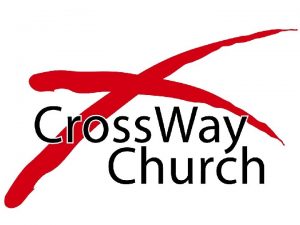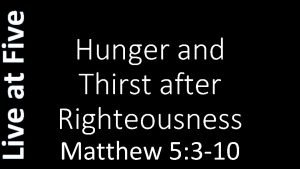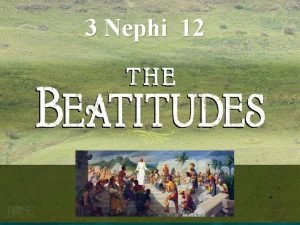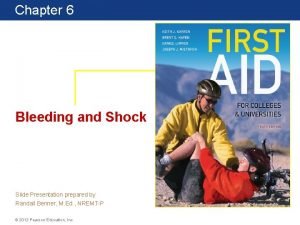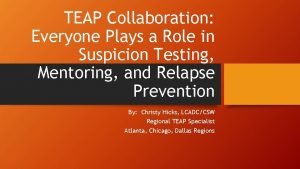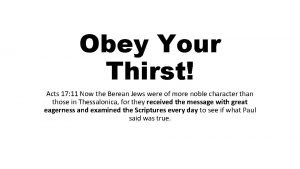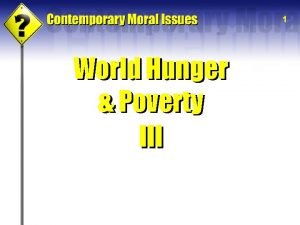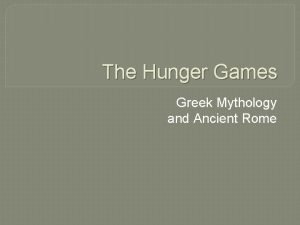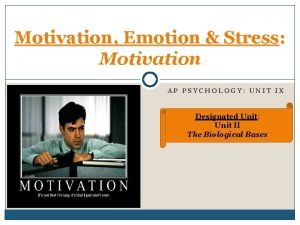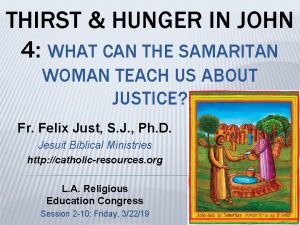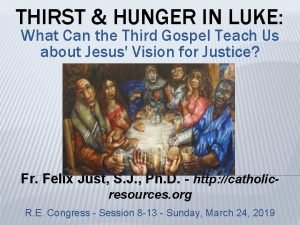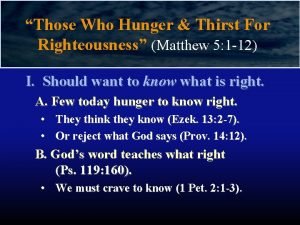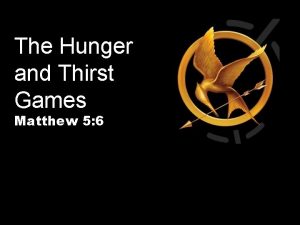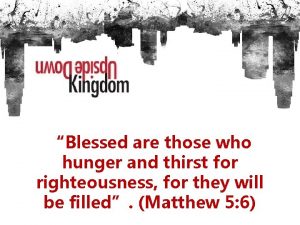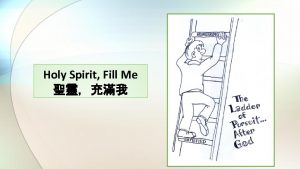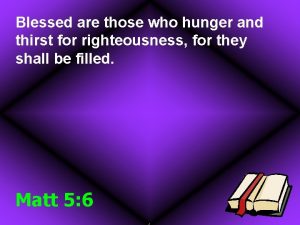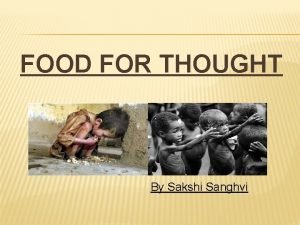THIRST HUNGER IN JOHN 4 WHAT CAN THE



































![John 4: 20 -24 – Dialogue Continues [Woman continues]: 20 “Our ancestors worshiped on John 4: 20 -24 – Dialogue Continues [Woman continues]: 20 “Our ancestors worshiped on](https://slidetodoc.com/presentation_image_h2/0e18eb3ff8ef3230a5dfc81948e1a958/image-36.jpg)






























- Slides: 66

THIRST & HUNGER IN JOHN 4: WHAT CAN THE SAMARITAN WOMAN TEACH US ABOUT JUSTICE? Fr. Felix Just, S. J. , Ph. D. Jesuit Biblical Ministries http: //catholic-resources. org L. A. Religious Education Congress Session 2 -10: Friday, 3/22/19

THANK YOU! Ù For participating in R. E. Congress! Ù For sharing our faith as catechists! Ù For helping in many other ministries! 2

WORKSHOP TITLE & DESCRIPTION Thirst & Hunger in John 4: What Can the Samaritan Woman Teach Us About Justice? “The biblical story of Jesus’ encounter with the Samaritan woman in John 4 is so much deeper than you might realize, dealing with themes of thirst as well as hunger, on the physical and spiritual levels, for both individuals and communities. This workshop will explore in depth this important Johannine story, which is read on the Third Sunday of Lent and used in the Rite of Christian Initiation of Adults Scrutinies. ” 3

Lenten Scrutiny Gospels n 3 rd Sunday of Lent – WATER: ¨ The Samaritan Woman at the Well (John 4: 1 -42) n 4 th Sunday of Lent – LIGHT: ¨ The Man Born Blind (John 9: 1 -41) n 5 th Sunday of Lent – LIFE: ¨ Martha, Mary, and Lazarus (John 11: 1 -54)

The Samaritan Woman - DUCCIO di Buoninsegna

The Man Born Blind – DUCCIO di Buoninsegna

The Raising of Lazarus – DUCCIO di Buoninsegna

“The Gift Triptych” – by John August Swanson

GOSP. JOHN VS. SYNOPTIC GOSPELS Ù Most stories in John are NOT in Synoptics; Most material in Synoptics are NOT in John § Outside of the Passion Narrative, the only exception is the Feeding of the 5000! Ù Synoptics are often considered “historical” while John more “spiritual” & “theological” § All four Gospels: both historical and theological! § But differing circumstances & different recipients led to different historical & theological emphases 9

John vs. Synoptics 1) Material found only in the Fourth Gospel, not in the Synoptics (Matt, Mark, Luke): n Prologue (1: 1 -18) n "Signs, " starting with Wedding at Cana (2: 1 -12) n Dialogue with Nicodemus (2: 23— 3: 21) n Samaritan Woman at the Well (4: 1 -42) n Sick Man at the Pool of Bethesda (5: 1 -18)

John vs. Synoptics (cont. ) 1) Material only in John, not in Synoptics (cont. ): n Man Born Blind (9: 1 -41) n Lazarus Raised from the Dead (11: 1 -44) n Washing the Disciples’ Feet (13: 1 -20) n Last Supper Discourses (13: 31— 16: 33) n Great Prayer of Jesus (17: 1 -26) n Resurrection Appearance to Mary Magdalene (20: 11 -18; cf. Matt 28: 9) n Resurrection Appearance to Thomas (20: 24 -29)

John vs. Synoptics (cont. ) 2) Synoptic materials p p p p p No Infancy Narrative No Childhood Episodes No Baptism of Jesus No Temptation in the Desert No Calls to Repentance No Sermon on the Mount No Beatitudes No Lord’s Prayer No List of "Twelve Apostles" not in John’s Gospel: p p p p No Parables No "Kingdom of God" No Ethical Teachings No Exorcisms No Transfiguration No Passion Predictions No Institution of the Eucharist at the Last Supper No Predictions of Jesus’ Return

Gosp. John vs. Synoptic Gospels p John doesn’t repeat most Synoptic materials, but assumes you already know them! n It doesn’t contradict, but supplements the Synoptics and/or provides new & different emphases. n John has no direct “social justice” stories or commands: “feed the hungry, clothe naked, etc. ” n John assumes we already know and do 13

Symbols of the Four Evangelists St. Ignatius Church, SF

Conventions of Ancient Theater Only two “active characters” on stage at any time ¨ “Characters” can be individuals or groups. ¨ Other characters may be nearby, or looking on silently, but not engaged in the dialogue or action. ¨ This convention helps readers determine the “scenes” into which a larger story can be subdivided. n Apply 4: this to John 11, John 9, and John

Mary, Martha, Lazarus (John 11: 1 -54) A) 1 -6: Introduction: Jesus receives a message from Martha and Mary about Lazarus’ illness B) 7 -16: Jesus and his disciples talk about Lazarus and the meaning of death C) 17 -27: Jesus and Martha talk about resurrection and eternal life C') 28 -37: Jesus and Mary express both deep sorrow and great love B') 38 -44: Jesus calls Lazarus out of the tomb, raising him from the dead A') 45 -54: Conclusion: Reactions of people who saw or heard about the raising of Lazarus

The Man Born Blind (John 9: 1 -41) A) 1 -5: Jesus & the disciples relation of sin & blindness B) 6 -7: Jesus & the blind person bringing the person to physical sight C 1) 8 -12: neighbors & ex-blind person question of person’s identity; process of healing D 1) 13 -17: ex-blind person & Pharisees discussion of Jesus’ origin: from God? sinful? C 2) 18 -23: parents & Jewish authorities question of person’s identity; process of healing D 2) 24 -34: ex-blind person & authorities discussion of Jesus’ origin: from God? sinful? B') 35 -38: Jesus & ex-blind person bringing the person to full spiritual insight A') 39 -41: Jesus & the Pharisees relation of sin & blindness

Jesus & Samaritan Woman (Jn 4: 1 -42) A) 1 -4: Transition: Departure from Judea toward Galilee B) 5 -6: Jesus arrives at Jacob’s well near Sychar in Samaria C) 7 -15: Dialogue: Jesus & Woman, about Water & Thirst D) 16 -26: Dialogue: Jesus & Woman, about Worship and the Messiah A') 27: Transition: Disciples return & wonder about the Woman B') 28 -30: Woman tells her villagers about the

John 4: 1 -42 – Overview § Lectionary for Mass: § Year A: Third Sunday of Lent (RCIA Scrutinies) § Multiple Dialogues § Dual-meanings: § Flowing/living Water § Thirst: physical/eternal § True Worship § Messiah / “I Am” 19

John 4 – Geography A) Transition: Departure from Judea to Galilee 1 Now when Jesus learned that the Pharisees had heard, “Jesus is making and baptizing more disciples than John” 2 -although it was not Jesus himself but his disciples who baptized-- 3 he left Judea and started back to Galilee. 4 But he had to go through Samaria. n Headed north (2: 13– 3: 21 Jesus

John 4: 1 -42 B) Arrival at Jacob’s Well near Sychar in Samaria 5 So he came to a Samaritan city called Sychar, near the plot of ground that Jacob had given to his son Joseph. 6 Jacob’s well was there, and Jesus, tired out by his journey, was sitting by the well. It was about noon. n Jacob’s well – lit. “spring” (pēgē), but translated “well” most in English Bibles; no direct mention in OT of this “gift” n Gen 33: 18– 19; 48: 22 – OT

John 4: 1 -42 – Jesus & Samaritan Woman C) Dialogue of Jesus and Samaritan Woman about Water & Thirst 7 A Samaritan woman came to draw water, and Jesus said to her, “Give me a drink. ” 8(His disciples had gone to the city to buy food. ) 9 The Samaritan woman said to him, “How is it that you, a Jew, ask a drink of me, a woman of Samaria? ” (Jews do not share things in common with Samaritans. ) 10 Jesus answered her, “If you knew the gift of God, and who it is that is saying to you, ‘Give me a drink, ’ you would have asked him, and he would have given you living water. ” Lots going on here: n Jesus’ Disciples & the Woman

Disciples in John’s Gospel n No “apostles” in John Gk. apostolos only in 13: 16 = generic “messenger” ¨ Verb apostello used mostly of Jesus, sent by God! ¨ Jesus has “disciples, brothers/sisters, friends” ¨ n First five disciples (1: 19 -51; and later refs. ) Andrew & Anon. ; Simon/Peter; Philip & Nathanael ¨ Jesus often dialogues with them (Q & A) ¨ ¨ “The Twelve” n Not individually named; ref. only in 6: 67 -71; 20: 24 ¨ The “Disciple Whom Jesus Loved (BD)” n From Last Supper to Resurrection (also earlier? ) ¨ Other named & anonymous disciples (next screen)

Named & Anonymous Disciples n Jesus’ mother (2: 1 -12; 6: 42; 19: 25 -27) n Judas Iscariot (6: 70 -71; 12: 4 -8; 13: 2, 21 -30; 18: 2 -5) n Man Born Blind (9: 1 -41, esp. v. 28) n Martha, Mary, Lazarus of Bethany (11: 1 -45; 12: 1 -8) n Thomas Didymus/Twin (11: 16; 14: 5; 20: 24 - 28; 21: 2) n Another Judas (14: 22) n Mary of Magdala (19: 25; 20: 1 -2; 20: 11 -18) n “his mother’s sister, Mary the wife of

Women in the Fourth Gospel 2: 1 -12 n 4: 1 -42 n 11: 1 -45 Mother of Jesus at Cana Wedding Samaritan Woman at the Well Martha & Mary intercede with Jesus for their brother Lazarus n 12: 1 -8 Mary of Bethany anoints Jesus n 19: 25 b-27 Mother of Jesus & other Women at Foot of Cross (incl. “Mary of Clopas”) n 20: 1 -2 Mary Magdalene discovers Tomb Empty n 20: 11 -18 Jesus Appears to Mary Magdalene n n [8: 1 -11] Adulterous Woman [not originally in John’s Gospel]

Tensions: Jews & Samaritans Roots in the History of Israel: n Ca. 1300 -1030 BC – Confederation of 12 Tribes ¨ n 1030 -930 BC – United Monarchy ¨ n Moses, Joshua, Judges, Prophet Samuel Kings Saul, David, Solomon 930 -721 -587 BC – Divided Monarchy ¨ Northern Kingdom: 10 Tribes of Israel; capital Samaria n n ¨ Conquered by Assyrian Empire in 721 BC Assyrians deport many Israelites, import foreign peoples Southern Kingdom: Judah (& Benjamin); capital Jerusalem n Conquered by Babylonian Empire in 587 BC

Tensions: Jews & Samaritans n 5 th to 3 rd Centuries BC – Persian & Greek eras Judea (south) & Samaria (north) are separate districts ¨ Judeans develop “Judaism” – full Bible (Ta. Na. K) ¨ Samaritans only accept Torah (five books of Moses) ¨ n 2 nd & 1 st Centuries BC Ca. 160’s to 63 BC: Macabbean/Hasmonean era ¨ Judea regains its independence; slowly expand north ¨ 111 BC – Judeans (Jews) re-conquer Samaria, and destroy Samaritan temple on Mount Gerizim! ¨ 63 BC – Romans take over all of Israel/Palestine; Judea & Samaria part of same Roman-governed district ¨

Tensions: Jews & Samaritans n First Century AD (Jesus’ lifetime): Jews consider Samaritans as foreigners, enemies, “half-breeds” at best, who don’t follow all of God’s Law ¨ Samaritans resent that Jews destroyed their temple! (ca. 140 years earlier; days of their long-ago ancestors!) ¨ n “Samaritan” used as an insult: ¨ Opponents tell Jesus: “Are we not right in saying that you are a Samaritan and are possessed? ” (Jn 8: 48) But Jesus doesn’t seem to mind! He doesn’t see “Samaritans” as enemies, but as humans!

“Samaritans” in LUKE & Acts n Lk 9: 52 -53 – Samaritan Villagers refuse hospitality ¨ n Lk 10: 29 -37 – Parable of the Good Samaritan ¨ n in response to “Who is my neighbor? ” Lk 17: 11 -19 – Jesus heals Ten Lepers ¨ n But rather than calling down punishment from heaven upon them, as James and John suggest, Jesus and his disciples simply go to another (also Samaritan!) village. One of them was a Samaritan, the only one to return and give thanks to Jesus. Acts – Church’s mission reaches out to Samaritans ¨ Acts 1: 8; 8: 1 -25; 9: 31; 15: 3.

John 4: 7 -10 – Initial Dialogue 7 A Samaritan woman came to draw water, and Jesus said to her, “Give me a drink. ” 8(His disciples had gone to the city to buy food. ) 9 The Samaritan woman said to him, “How is it that you, a Jew, ask a drink of me, a woman of Samaria? ” (Jews do not share things in common with Samaritans. ) 10 Jesus answered her, “If you knew the gift of God, and who it is that is saying to you, ‘Give me a drink, ’ you would have asked him, and he would have given you living water. ” n Multiple Meanings of words: ¨ “living water” = “flowing water” = spring water

Multiple Meanings & Misunderstandings Jesus speaks; people think he means a physical/historical level; Jesus or Evangelist then clarify: it’s meant on a spiritual level! n 2: 19 -22 - “Destroy this temple, and in three days I will raise it up” – Jerusalem temple? n 3: 3 -10 - “No one can see the Kingdom of God without being born anôthen” – born a second time? n 4: 10 -15 - “he would have given you living water” – flowing water? n 4: 32 -34 - “I have food to eat that you do not know about” – lunch? n 6: 41 -51 - “I am the bread that came down from heaven” –

n n n Multiple Meanings & Misunderstandings 8: 21 -29 - “I am going away, and you will search for me, but you will die in your sin. Where I am going, you cannot come. ” – suicide? 8: 31 -47 - “you will know the truth, and the truth will make you free. ” – we’ve never been slaves! 8: 56 -59 - “Your ancestor Abraham rejoiced that he would see my day; he saw it and was glad. ” – you’re not yet 50 years old! 11: 11 -15 - “Our friend Lazarus has fallen asleep, but I am going there to awaken him. ” – sleeping? 12: 27 -33 - “Father, glorify your name. ” Then a voice came from heaven, “I have glorified it, and I will glorify it again. ” – thunder, or angel? 14: 4 -6 - “You know the way to the place where I am going” –

John 4: 1 -42 – Jesus & Samaritan Woman 10 Jesus answered her, “If you knew the gift of God, and who it is that is saying to you, ‘Give me a drink, ’ you would have asked him, and he would have given you living water. ” 11 The woman said to him, “Sir, you have no bucket, and the well is deep. Where do you get that living water? 12 Are you greater than our ancestor Jacob, who gave us the well, and with his sons and his flocks drank from it? ” 13 Jesus said to her, “Everyone who drinks of this water will be thirsty again, again 14 but those who drink of the water that I will give them will never be thirsty The water that I will give will become in them a spring of water gushing up to eternal life. ” 15 The woman said to him, “Sir, give me this water, so that I may never be thirsty or have to keep coming here to draw water. ”

What is the “Living Water”? Holy Spirit ! Biblical Images for Holy Spirit: Wind Fire Dove Water!

John 4: 1 -42 – Dialogue Continues D) Dialogue of Jesus and Samaritan Woman about Worship & Messiah 16 Jesus said to her, “Go, call your husband, and come back. ” 17 The woman answered him, “I have no husband. ” Jesus said to her, “You are right in saying, ‘I have no husband’; 18 for you have had five husbands, and the one you have now is not your husband. What you have said is true!” 19 The woman said to him, “Sir, I see that you are a prophet…. ” n n Why does Jesus make this request? Is he changing the topic? Prophet – not just “clairvoyant” nor “predicting the future”! ¨ Biblical pro-phetes = one who “speaks on behalf of” God!
![John 4 20 24 Dialogue Continues Woman continues 20 Our ancestors worshiped on John 4: 20 -24 – Dialogue Continues [Woman continues]: 20 “Our ancestors worshiped on](https://slidetodoc.com/presentation_image_h2/0e18eb3ff8ef3230a5dfc81948e1a958/image-36.jpg)
John 4: 20 -24 – Dialogue Continues [Woman continues]: 20 “Our ancestors worshiped on this mountain, but you say that the place where people must worship is in Jerusalem. ” 21 Jesus said to her, “Woman, believe me, the hour is coming when you will worship the Father neither on this mountain nor in Jerusalem. 22 You worship what you do not know; we worship what we know, for salvation is from the Jews. 23 But the hour is coming, and is now here, when the true worshipers will worship the Father in spirit and truth, for the Father seeks such as these to worship him. 24 God is spirit, and those who worship him must worship in spirit and truth. ” n Woman now asks something deeper, a religious question:


25 The John 4: 1 -42 – First Dialogue Concludes woman said to him, “I know that Messiah is coming” (who is called Christ). “When he comes, he will proclaim all things to us. ” 26 Jesus said to her, “I am [he], the one who is speaking to you. ” n n n Woman again changes topic, going deeper in seeking truth! Messiah? Jews expected God to send an “Anointed One” as leader ¨ Did most Samaritans also expect a “Messiah”? Jesus answers with this Gospel’s first “I AM” statement ¨ Alluding to Divine Name (tetragrammaton) – cf. Exod

John 4: 1 -42 – Second Half (vv. 2742) A’) Transition: Jesus’ Disciples Return and Wonder about the Woman 27 Just then his disciples came. They were astonished that he was speaking with a woman, but no one said, “What do you want? ” or, “Why are you speaking with her? ” n Semitic cultures: men and women generally didn’t interact. (often still don’t today!) n Again, for Jesus this is a non-issue!

John 4: 1 -42 – Second Half (vv. 2742) B’) Samaritan Woman tells Villagers about the Messiah 28 Then the woman left her water jar and went back to the city. She said to the people, 29“Come and see a man who told me everything I have ever done! He cannot be the Messiah, can he? ” 30 They left the city and were on their way to him. n Why did she leave her water jar behind? answer on historical level? ¨ answer on spiritual level? ¨ n Note: Woman uses a “hesitant question” it doesn’t express her own doubt ¨ but subtly invite a “yes” answer! ¨

John 4: 1 -42 – Second Half (vv. 2742) C’) Dialogue of Jesus and His Disciples about Food & Work 31 Meanwhile the disciples were urging him, “Rabbi, eat something. ” 32 But he said to them, “I have food to eat that you do not know about. ” 33 So the disciples said to one another, “Surely no one has brought him something to eat? ” 34 Jesus said to them, “My food is to do the will of him who sent me and to complete his work. n Another double-meaning (food), with misunderstanding, then clarification

John 4: 1 -42 – Second Half (vv. 2742) 35 Do you not say, ‘Four months more, then comes the harvest’? But I tell you, look around you, and see how the fields are ripe for harvesting. 36 The reaper is already receiving wages and is gathering fruit for eternal life, so that sower and reaper may rejoice together. 37 For here the saying holds true, ‘One sows and another reaps. ’ 38 I sent you to reap that for which you did not labor. Others have labored, and you have entered into their labor. ” n No “parable” stories in John, as are common in Synoptic Gospels Somewhat related are Good Shepherd (Jn 10) and Vine & Branches (Jn 15) ¨ And this text, usually common sayings & agricultural images symbolically; emphasizing cooperation, not competition, in working for God’s ministry ¨

John 4: 1 -42 – Second Half (vv. 2742) D’) Reaction of Samaritans to the Woman & to Jesus 39 Many Samaritans from that city believed in him because of the woman’s testimony, “He told me everything I have ever done. ” 40 So when the Samaritans came to him, they asked him to stay with them; and he stayed there two days. 41 And many more believed because of his word. 42 They said to the woman, “It is no longer because of what you said that we believe, for we have heard for ourselves, and we know that this is truly the Savior of the world. ” n n Are the Samaritan villagers putting the woman down? – NO! Point here: Coming to believe in Jesus based on other

Discipleship in John: “Believing” p Biblical Vocabulary n “Faith” (pisti. V; noun) – esp. in Paul p n “Have Faith” sounds like possessing an object “Believe” (pisteuw; verb) – esp. in John p Action: to trust, entrust oneself to, believe in

“Believing” in the Fourth Gospel p John never uses the noun (“faith, belief”), but always/only the verb (“to believe”) n n p Believing involves relationship n p Even better translation: “trusting someone” or “entrusting oneself to someone” Synonyms for “believing”: n p Believing is an action one does Not an object one possesses (not “having faith”) knowing, seeing, receiving, coming to, accepting, remaining, etc. Opposites of “believing” n “not believing, rejecting, denying, not receiving, going

Possible Reactions to Jesus in FG 1. Refusing to believe, despite seeing/hearing p 2. Beginning to believe, but not fully knowing p 3. Ex. : Nicodemus, Joseph Arimathea; some “Jews” Seeing and believing; becoming a disciple p 5. Ex. : “crowds”; some early “disciples”; some “Jews” Believing, but being afraid to profess publicly p 4. Ex. : “world”; “chief priests”; most “Jews” Ex. : “disciples”; Samaritans; blind man; Thomas Believing even without seeing, just

Texts with “Believe” in John p Believe! n w/o direct object; “You just gotta trust”! p Believe IN God / IN me / IN… NT Greek lit. says “believe INTO…” n “put your trust in/into God & Jesus” n “entrust yourself to God & Jesus” n p Believe n Trust God/Jesus; believe what he says p Believe n ME/HIM/… THAT… Doctrines/beliefs about God & Jesus

Results/Effects of Believing p Becoming "children of God" (1: 12) p Having "eternal life" (3: 15 -16, 36; 5: 24; 6: 40, 47) p p p p Not "perishing" (3: 16); not "being condemned" (3: 18) Not "coming under judgment" (5: 24); never being "hungry/thirsty" (6: 35) "Knowing" Jesus and the Father (4: 42; 6: 64, 69; 10: 38) Passing from death to life (5: 24); living and never dying (11: 25 -26) Having "living water" flow out of one's heart (7: 38) Receiving the Spirit (7: 39) Being "disciples" of Jesus (8: 31); being Jesus' "friends" (15: 14 -15) Seeing the "glory of God" (11: 40); seeing "greater things"

Recap: Implications for “Justice” n Fourth Gospel emphasizes “discipleship of equals” All believers are children of God, friends of Jesus, filled with Holy Spirit (“living water”), brothers & sisters to one another ¨ No one has privileged status (“apostles”; “teachers”; ¨ “kings”; etc. ) n FG emphasizes the prominent role of women As those who themselves believe in Jesus! ¨ As those who bring other people to believe! ¨ n FG presents other external differences as irrelevant

n Caution: Danger of Over. Spiritualizing When Jesus speaks in John’s Gospel, don’t misunderstand him (earthly/physical/historical levels) when he means the spiritual/theological level. This doesn’t imply the earthly level is unimportant. ¨ John takes “social justice concerns” for granted (as expressed more explicitly in Gospels of Matthew & Luke). ¨ Helping those with physical hunger & thirst is essential. Yet spiritual hunger & thirst are even more important! ¨ How do we see evangelization & social ministry related? ¨ n Two main “commandments” in John: Believe in Jesus (as Word made flesh, Son of God) ¨ Love one another (not only believers; but everyone) ¨

HOW CAN I LEARN MORE? http: //catholic-resources. org Ù Fr. Felix Just’s Biblical/Theological Website (if you forget the URL, just Google my name!) Catholic Bible Institute(s) Ù Archdiocese of Los Angeles Ù Diocese of San Bernardino Ù Diocese of Orange Ù Diocese of Tucson 51

Audio CD Programs by Fr. Felix • The New Testament: A Guided Tour • The Lectionary: A Treasure for Liturgy & Prayer • What Is Faith? Gift, Mystery, Life! • A Retreat with the Gospel of Matthew • A Retreat with the Gospel of Mark • A Retreat with the Gospel of Luke • A Retreat with the Gospel of John • Available from Fr. Felix or "Now You Know Media"

Biblical Pilgrimages • May 2019: Holy Land • May 2020: Austria & Germany, esp. Passion Play in Oberammergau • May 2021: Turkey • May 2022: Holy Land • May 2023: Greece

THANK YOU FOR ATTENDING CONGRESS! Questions? Comments? Discussion? May your hunger and thirst for God lead you to believe more deeply in Jesus, and to love one another as God’s beloved! 54

55

John 2: 1 -12 – Mother of Jesus at Cana § Lectionary for Mass: § Year C: Second Sunday of Ordinary Time § Also weekday: Jan. 7 (only if Epiphany is Jan. 8) § “Inaugural Event” of John’s Gospel § First “Sign” Jesus performs in Cana of Galilee § Result: His disciples begin to “believe” in Jesus § Mother’s Role? 56

John 11: 1 -45 – Raising of Lazarus? § Lectionary for Mass: § Year A: Fifth Sunday of Lent (RCIA Scrutinies) § Long, complex drama § Centers on two dialogues of Jesus with the sisters § Martha’s “confession” among strongest of NT: “Yes, Lord; I have believed that you are 57

John 12: 1 -8 – Mary of Bethany anoints Jesus Lucas Moser (1432) 58

John 12: 1 -8 – Mary of Bethany anoints Jesus § Lectionary for Mass: § Sundays: not used § Weekdays: Monday of Holy Week § John’s Anointing Story: Different from Synoptics § Anointer named: Mary of Bethany, sister of Martha & Lazarus § Not Mary Magdalene, nor anonymous, as in Synoptics § She’s not called a “sinner” (as in Luke 7) § Mary anoints Jesus’ feet (not his head, as in Mt & Mk) 59

John 19: 25 b-27 – Women at the Cross William Blake Jacques Tissot 60

John 19: 25 b-27 – Women at the Cross § Lectionary for Mass: § Good Friday: part of the full Passion Proclamation § Jesus’ Mother and Other Women § “Meanwhile, standing near the cross of Jesus were his mother, and his mother's sister, Mary the wife of Clopas, and Mary Magdalene. ” (v. 25 b) § “When Jesus saw his mother and the disciple whom he loved standing beside her, he said to his mother, ‘Woman, here is your son. ’ / Then he said to the disciple, ‘Here is your mother. ’ 61

John 20: 1 -2 – Mary Magdalene at Empty Tomb 62

John 20: 1 -2 – Mary Magdalene at Empty Tomb § Lectionary for Mass: § Easter Sunday: Years A/B/C (John 20: 1 -9) § How many women went to the tomb? § “Early on the first day of the week, while it was still dark, Mary Magdalene came to the tomb and saw that the stone had been removed from the tomb. / So she ran and went to Simon Peter and the other disciple, the one whom Jesus loved, and said to them, ‘They have taken the Lord out of the tomb, and we do not know where they have laid him. ’ ” 63

John 20: 11 -18 – Jesus Appears to Mary Magd. Sir Edward Burne-Jones: “The Morning of the Resurrection” 64

John 20: 11 -18 – Jesus Appears to Mary Magd. § Risen Jesus appears first to Mary Magdalene § Mary weeps; Jesus “Woman, why are you weeping? ” § Mary turns, but mistakes Jesus for the gardener § Jesus calls her name: “Mary!” She turns and recognizes § “Do not hold on to me” (noli me tangere) § Jesus commissions her with a message for the disciples 65

John 20: 11 -18 – Jesus Appears to Mary Magd. 66
 Osmometric thirst and volumetric thirst
Osmometric thirst and volumetric thirst What does it mean to hunger and thirst after righteousness
What does it mean to hunger and thirst after righteousness Hunger and thirst for righteousness object lesson
Hunger and thirst for righteousness object lesson What are the 12 beatitudes
What are the 12 beatitudes Matthew 5 6
Matthew 5 6 Sprite slogans
Sprite slogans Thirst cycle
Thirst cycle Thirst teap
Thirst teap Saurabh paranjape location
Saurabh paranjape location Obey your thirst
Obey your thirst Osmoreceptors thirst
Osmoreceptors thirst John arthur world hunger and moral obligation
John arthur world hunger and moral obligation Hình ảnh bộ gõ cơ thể búng tay
Hình ảnh bộ gõ cơ thể búng tay Slidetodoc
Slidetodoc Bổ thể
Bổ thể Tỉ lệ cơ thể trẻ em
Tỉ lệ cơ thể trẻ em Voi kéo gỗ như thế nào
Voi kéo gỗ như thế nào Tư thế worm breton
Tư thế worm breton Alleluia hat len nguoi oi
Alleluia hat len nguoi oi Môn thể thao bắt đầu bằng từ chạy
Môn thể thao bắt đầu bằng từ chạy Thế nào là hệ số cao nhất
Thế nào là hệ số cao nhất Các châu lục và đại dương trên thế giới
Các châu lục và đại dương trên thế giới Cong thức tính động năng
Cong thức tính động năng Trời xanh đây là của chúng ta thể thơ
Trời xanh đây là của chúng ta thể thơ Cách giải mật thư tọa độ
Cách giải mật thư tọa độ Làm thế nào để 102-1=99
Làm thế nào để 102-1=99 độ dài liên kết
độ dài liên kết Các châu lục và đại dương trên thế giới
Các châu lục và đại dương trên thế giới Thể thơ truyền thống
Thể thơ truyền thống Quá trình desamine hóa có thể tạo ra
Quá trình desamine hóa có thể tạo ra Một số thể thơ truyền thống
Một số thể thơ truyền thống Cái miệng xinh xinh thế chỉ nói điều hay thôi
Cái miệng xinh xinh thế chỉ nói điều hay thôi Vẽ hình chiếu vuông góc của vật thể sau
Vẽ hình chiếu vuông góc của vật thể sau Nguyên nhân của sự mỏi cơ sinh 8
Nguyên nhân của sự mỏi cơ sinh 8 đặc điểm cơ thể của người tối cổ
đặc điểm cơ thể của người tối cổ V cc
V cc Vẽ hình chiếu đứng bằng cạnh của vật thể
Vẽ hình chiếu đứng bằng cạnh của vật thể Fecboak
Fecboak Thẻ vin
Thẻ vin đại từ thay thế
đại từ thay thế điện thế nghỉ
điện thế nghỉ Tư thế ngồi viết
Tư thế ngồi viết Diễn thế sinh thái là
Diễn thế sinh thái là Dot
Dot Số nguyên là gì
Số nguyên là gì Tư thế ngồi viết
Tư thế ngồi viết Lời thề hippocrates
Lời thề hippocrates Thiếu nhi thế giới liên hoan
Thiếu nhi thế giới liên hoan ưu thế lai là gì
ưu thế lai là gì Khi nào hổ con có thể sống độc lập
Khi nào hổ con có thể sống độc lập Khi nào hổ mẹ dạy hổ con săn mồi
Khi nào hổ mẹ dạy hổ con săn mồi Sơ đồ cơ thể người
Sơ đồ cơ thể người Từ ngữ thể hiện lòng nhân hậu
Từ ngữ thể hiện lòng nhân hậu Thế nào là mạng điện lắp đặt kiểu nổi
Thế nào là mạng điện lắp đặt kiểu nổi Hunger games trivia questions
Hunger games trivia questions The hunger games settings
The hunger games settings The hunger games chapter 20
The hunger games chapter 20 What is katniss’ prediction as she readies herself?
What is katniss’ prediction as she readies herself? Hunger games theseus and the minotaur
Hunger games theseus and the minotaur What is district 4 in the hunger games
What is district 4 in the hunger games Hunger games tessera
Hunger games tessera The hunger games copyright
The hunger games copyright Hunger games book author
Hunger games book author How does the brain work
How does the brain work How many reaping entries will katniss have in her 16th year
How many reaping entries will katniss have in her 16th year Motivation hunger
Motivation hunger Hunger motivation ap psychology definition
Hunger motivation ap psychology definition

